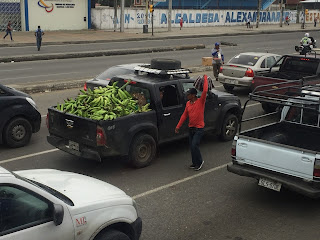
I made it to the Equator!
There are at least three Equator monuments along the 0 degree latitude line just north of Quito, and this is one of the small, not-so-touristy spots. Before I left Portland, a wise woman pointed out to me that I was heading to the center of the earth to center myself. I like that idea. I'm still doing a lot of inner work on accepting my reality, and what I want to do with my new-found freedom, but I'm reveling in the opportunity to learn, grow and focus my life on me.
Over the course of this last week, there were three very "Oh My Gosh, I'm in Ecuador" moments that I'd like to share. The first, was getting the chance to put a foot in both the north and south hemispheres at the same time.
 |
| This monument is inlaid into the ground at the equator. I really liked its sentiment. |
 |
| Experiencing the Equator and Greeting Man with my friend Ava |
+++++++++++++++++++++++++++++++++++++++++++++++++++++
The second experience that brought a deep smile to my soul was our visit to the northern reaches of Ecuador and the Chota Valley. Our group of volunteers took an overnight trip to visit this beautiful valley, made green by the fields of sugar cane, to visit an AfroEcuatorian community named Chota. Historically, spaniards brought Africans to Ecuador as slaves for the wealthy owners of the ranches, or haciendas. These slaves won their freedom earlier than North American slaves but often had to continue to work for the haciendas to be able to survive. So, small African-Ecuadorian communities formed in this agricultural valley and the richness of their culture survives today.
This is the small village of Chota where we were warmly greeted by a women's group who share their history, hospitality and hugs with whomever wants to come and enjoy their community. Our host mom, Pilar, cooked and cared for Rachel (from California), Maddie (from Chicago) and I in her home. Obviously payments for our room and board is a source of income for this very poor community.
 |
| Our home for the night |

 |
| Always a first course of soup, then chicken, rice and some vegetables. We were also lucky enough to get some maduras (or boiled / sautéed bananas) and papaya juice! |
Interestingly enough, this tiny valley has quite a soccer culture, and many of the country's top stars emerged from these meager beginnings. Too bad we didn't get to play soccer, but we did get to see their beautiful, fully lit, soccer field. It's a source of pride for this community. Sorry - no close up pictures of the field, or their soccer stars!
 |
+++++++++++++++++++++++++++++++++++++++++++++++++++++
 |
| The last moment I want to share was when we visited the Peguche, an Indigenous village of the Otavalo people. First, they shared with us their beautiful school, music and traditional dances. |

Then, they took us to the beautiful Peguche Waterfall
for a traditional ceremony and blessing.
 |
| Walking to the waterfall among a forest of eucalyptus trees... It smelled so good! |


































































